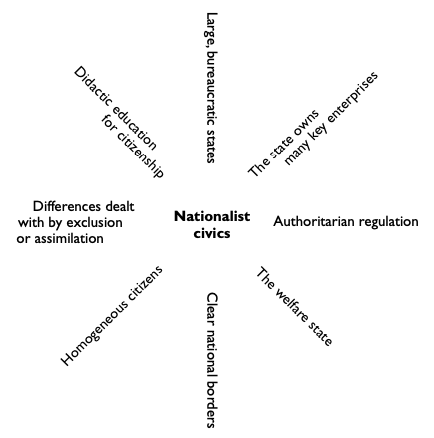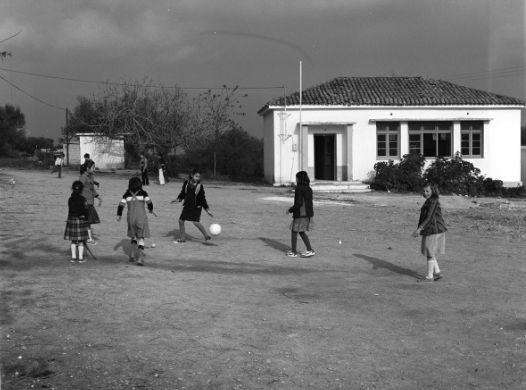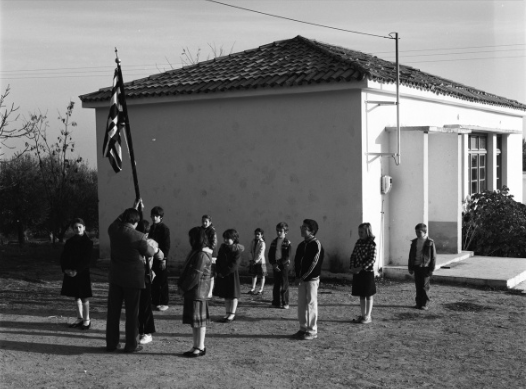Nationalism: The modern past
The relationship of the state to civil society can be understood in terms of the things that the state does: the manner in which it exerts power; the way that it provides services; the way in which people are expected to belong in the civic spaces fashioned by the state; and the way in which civility is inculcated, primarily through the education system.
Nationalism was the founding ideology and practice of the modern state.
Dimension 1: State power
Before modern times, societies often did not have a state that was separate from civil society (for example, hunter-and-gatherer societies). If a society had a state, it was frequently run on the basis of one form of hierarchical authority or another, such as the feudal relationship between a king or queen and their subjects. Gradually, the idea of a citizen evolved in which the state did not have total and unqualified control over the members of civil society. Citizens had rights that no ruler could simply ignore. Eventually, with the growth of democracy, civil society took control over the state – or, at least, that’s what democratic theory would anticipate. The rule of civil society was a partial achievement of ancient Athenian democracy, the English Magna Carta of 1215, the United States Constitution of 1787 and the French Revolution of 1789. Modern societies are governed on the basis that the state exists for the benefit of citizens and that the citizens ultimately control the state.
However, even in apparently democratic modern societies, citizens may feel themselves relatively powerless in the face of the power of the state. In fact, many modern states, although they say they are looking after the interests of citizens, have been far from democratic. Imperialism is the impulse of states to conquer and take over the territories of others in order to take the benefits of their resources. Fascism is a form of one-party authoritarian government that is racist, exclusionary and warlike in its desire to expand its territory. Communism in its classical, 20th-century Stalinist form is one-party dictatorship on behalf of ‘workers’ and ‘peasants’, in which the state is the owner of all property and the employer of everybody. The welfare state is a milder form of control in which the state conceives what services are good for citizens and provides those to them, sometimes compulsorily. Citizens don’t have much say over the details of everyday governance in the welfare state. All they can do is vote for a government every few years that will then decide things for them from a centralised position of power.
In one way or another, to different degrees and in different ways, the modern state commands and the modern citizen complies. In the case of the milder, welfare state the citizens have a chance to choose their government periodically, and the officials of the state have to be careful not to overstep the mark if their government is to be re-elected. But citizens still have little direct control over affairs of governance on a daily basis. The balance of agency is weighted in favour of the state at the expense of the citizen.
Dimension 2: Public services
Nationalism is the story of the relation of the citizen to the state, in which the state assures citizens of universal and identical rights. Or when this seems implausible (how is it that one person has enormous material resources when another has so few?), citizens are at least assured that the state will provide equal ‘opportunity’ or ‘equity’ (any citizen can become rich if they want to and try hard enough, or so the story goes). According to this theory, if the state provides everyone with the same schooling (the same curriculum, the same tests, the same class sizes), everyone will have the same opportunity to succeed.
This theory, however, is rather too simplistic. Because citizens start as unequals – by unequal inheritance of material and cultural capital, by being born as indigenous persons, or by being immigrants, for instance – universal and identical services do not produce equal outcomes. The curriculum of a school in a poor neighbourhood may be formally the same as the one in a more affluent neighbourhood, but the limit on resources available (numbers of teachers, textbooks, computers – at home and at school) will affect the quality of outcomes such that children can never keep pace with their peers in more affluent schools.
The state may try to compensate, to provide at least minimal specialist services that address the most serious injustices, such as remedial school interventions and community welfare programs. But no matter how much it tries, inequality seems to persist.
Dimension 3: Belonging and citizenship
The citizen of the modern state is what political philosopher Ernest Gellner calls ‘modular man’. Individuals have to be identical in order to be mobile and substitutable. Any worker or soldier has to be replaceable by another. This demands cultural homogeneity and standardisation of the national language (Gellner 1983). If a child comes to school speaking a foreign language or a dialect, it is the role of education to teach them the national language. This is how the nationalist state runs its own institutions and also how it supports the private labour market – by providing workers who speak the same language.
See Gellner on the Meaning of Nation.
The modern state also compensates for the unreliability and irregularities of the labour market. In fact, the strongest of modern states are those deliberately created as an antidote to the failure of the market to provide the necessities of life: fascism, communism and the welfare state (Polanyi 1975). The power mechanisms of these states are soaked with the principles of homogenisation – services such as mass education and social welfare provided identically to every person and on the basis of universal principles. At times, also, they explicitly excluded differences, sometimes viciously and even to the point of genocide in worst-case scenarios for indigenous, ethnic or religious minorities.
As well as this compensatory and redistributive function, nationalist states also serve the function of creating communal solidarity outside the market, even at times as an antidote to the market. The unattractive reality of the market is that isolated individuals can be substituted for each other at any time. Any worker is dispensable because another can be found to take their place.
Nationalism develops a consoling narrative of kinship and national belonging. This is a story that says there are millions of others who share the same sense of themselves by virtue of experiencing exactly the same things across time and space – from stories of national origins, to the news stories of the day presented through the mass media. Anderson calls these ‘imagined communities’ because they are real in the imagination, but not in their actual, cultural and spatial proximity (Anderson 1991).
See Anderson on the Nation as ‘Imagined Community’.
Nationalism is a social and political process that attempts to create a veneer of social/cultural sameness. In fact, the fiction of oneness is simply a method for dealing with difference. The modern, nationalist state has two ways of facing differences: either through direct exclusion or by requiring the assimilation of people defined as ‘outsiders’. Exclusion may be through codes of restriction that limit immigration or the movement of refugees, or promote apartheid, genocide and wars to redefine borders by ethnic sameness. To explain these exclusions, nationalists draw on the ideology of racism, which speaks of the superiority of the official national ‘us’ and provides the ostensible reasons why it is undesirable to live with ‘those others’.
Alternatively, assimilation meets difference by demanding that people become the same, that they make themselves identical and invisible by taking on the official language and national identity. Assimilation is, of course, a somewhat gentler form of racism than outright exclusion. The cultural and linguistic transformation entailed is sometimes supposed to be beneficial to the new citizen.
See John Dewey on the Assimilating Role of Public Schools.
Assimilation can be rationalised for what are apparently the best of reasons; the inherent virtues of ‘our’ progress or development in comparison to ‘yours’; ‘our’ level of ‘civilisation’ in comparison to ‘yours’. Be it by means of exclusion or assimilation, however, the intended result of nationalism is always the same: to create an homogeneous nation. One history plus one geography makes one state.
See American Citizenship, 1955.

Dimension 4: Learning civility
Modern nation-states take an interest in building the character of young people. By learning the stories of the state, they become loyal citizens. When they go to school, children salute the flag, sing the national anthem, study the historical narrative of the nation and learn to revere its iconic national heroes. Above all, they learn to be obedient servants of the state. They take oaths of loyalty. A picture of the head of state, prominently displayed on the classroom wall, watches over them. This is how civility is inculcated. It is not a coincidence that mass, compulsory, institutionalised education emerges in parallel with the development of the modern-nation state.
See Eleanor Roosevelt on Learning to be a Citizen.
More than any other place in the modern world, schools were the sites in which Gellner’s ‘modular man’ and modern nationalism were most decisively created. For the first time in history, the nation-state took away a large part of the socialisation of children from families and communities. Families and communities were diverse; their lifeworld experiences varied. Schools were to socialise all children into national ‘identity’. Education was the key to the creation of a culture of commonality.
In fact, nationalism extended all the way into the depths of the curriculum: teaching literacy in the official, ‘standard’ form of the language; and the history of national origins; and the geography of borders. Against these measures students were passed or failed, assimilated or left unassimilated.


